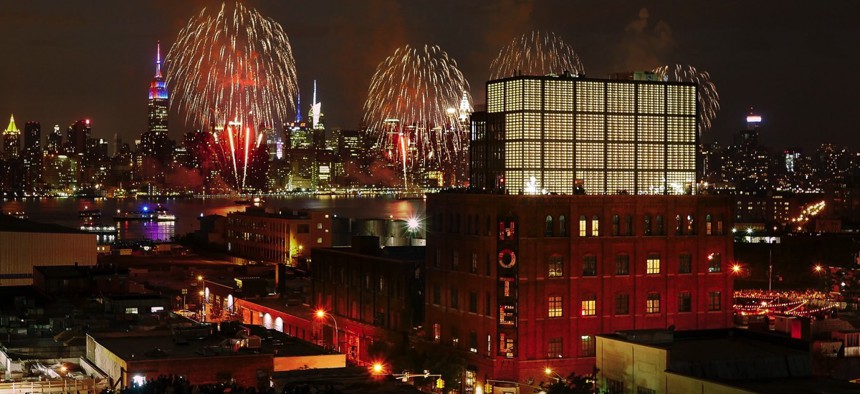Fireworks or Firearms? ShotSpotter Helps Police Tell the Difference

Fourth of July fireworks over New York City, which uses ShotSpotter technology to detect gunfire Grisha Levit / Flickr.com
Still, law enforcement can’t respond to every Fourth of July call.
Fourth of July weekend can be a busy time for some of the employees at SST, Inc.
The company makes ShotSpotter, a system that detects and locates gunfire using audio sensors that are similar to microphones.
The fireworks and “celebratory” gunshots that accompany some Independence Day festivities can create extra work for SST staff, especially those who review noises to see if they came from a firearm or some other, more benign, source.
“It’s popping,” the company’s president and CEO, Ralph Clark, said during an interview on Monday describing the holiday weekend that had just passed.
“We’re getting the fireworks a week before July Fourth, people can’t wait,” he said. After the holiday, the explosions will typically go on for about another three days, Clark explained. He said that people will continue to light off fireworks “until they run out of them.”
And that’s not all. “Because it’s summer, we’re having real gunfire go on,” he added. “It’s crazy.”
But the company has developed a number of ways to weed out extraneous sounds that get detected during July Fourth celebrations, as well as on New Year’s Eve and Cinco de Mayo. This helps to avoid situations where police departments get bombarded with frivolous alerts.
“They are making lots of strides as far as what to do during these more hectic times where you have lots of concussive events,” said Sgt. Monte May, who acts as an administrator of sorts for the ShotSpotter system used by the Kansas City, Missouri, police department.
About 90 departments around the U.S. currently use ShotSpotter, according to an SST spokesperson. Kansas City has been using the detection system since 2012.
In May’s view, SST is doing a “pretty good job” identifying actual instances of gunfire and developing “solutions so that we don’t get bogged down with 400 fireworks calls in an hour.”
Like most agencies that use ShotSpotter, the Kansas City Police Department depends on the company’s systems and staff to determine if and when gunfire has been detected.
The process works like this: Audio sensors mounted on streets, or in other areas, pick up a sound that resembles a gunshot and this sound registers with the company’s cloud software. These “boom” or “bang” noises are then quickly classified by an automated computer system that has “learned over the years,” according to Clark, to differentiate between gunshots and similar sounds that might come from passing helicopters, or the engine brakes of heavy trucks.
“The machine classification is very good,” Clark said. “But it’s not perfect.”
When the computer system can’t decide whether a sound is gunfire, a human ear is required. This is where SST’s incident review center comes in. “They’ll listen to two or three sensors worth of the recording snippet that we have,” Clark said.
This process can involve not only listening to sound recordings but also looking at the waveform images, which show the visual representation of an audio signal. Gunshot waveforms tend to look distinct, resembling pine trees tipped on their sides.
Review center staff members can work through a recording in just seconds, Clark said. They then make a call about how to classify the sound, and whether an alert should go out to the agency in the jurisdiction where it occurred.
Clark touted the fact that some of the review center employees might listen to 2,000 hours of gunfire in a year. “We have a number of people who are former ATF,” he added, referring to the The Bureau of Alcohol, Tobacco, Firearms and Explosives.
Still, he acknowledged that the reviewers aren’t flawless. “There are definitely some incidents that we’re sending over that aren’t gunshots,” he said.
While he would not reveal how many employees work in the review center, Clark did note that the company usually quadruples the number of staff on hand during the Fourth of July holiday.
Even when gunfire incidents are accurately classified, there are limits to what some of the busiest police agencies can accomplish using ShotSpotter alerts over Fourth of July weekend.
“Given the nature of what’s going on,” Clark said. “It’s really impossible for law enforcement to respond to every single person, maybe, stepping onto their porch and popping off one round.”
He explained that the company sometimes works out arrangements with agencies during times like these to only send an alert if two or three shots are detected.
May, the sergeant in Kansas City, said that last year the department there received about 300 ShotSpotter notifications on July Fourth. He was uncertain about this year’s figure.
After the holiday passes, Clark said that SST employees will go back and review single shot incidents that may have gone unscrutinized. Police officers in some places might then use this information, he said, to go knock on the door of a house where gunfire was heard.
“When they do those kinds of knock and talk things, you see people stop firing their weapons,” Clark said. “That same person who might’ve fired July Fourth, is not going to fire that gun, typically, on New Year’s Eve.”
(Photo by Grisha Levit / Flickr.com)
NEXT STORY: This County’s Flash-Flooding Advice for Residents: ‘Know Your Community’






